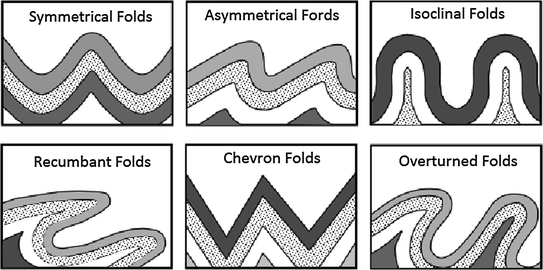Folding// geomorphic process and resultant landforms
- Folding is the result of rock strata bending due to compressional forces acting tangentially or horizontally towards a common point or plane from opposite directions.
- This process leads to the crumbling of strata into folds, forming a series of alternating troughs and crests.
- Upfolds are known as anticlines, and downfolds are termed synclines.
- Along the crest of the anticline, a zone of tension and weakness is present.
- Rivers flowing in this area breach the anticline, erode the material, and deepen the valley. Once fully eroded, the ridge is replaced by a valley, known as an anticlinal valley.
- This phenomenon exemplifies what is commonly referred to as inversion or relief topography.
- Between two anticlinal valleys, the synclinal portion stands higher than the valleys, forming a synclinal ridge.
- Approximately 400 million years ago, the great fold mountains of the world formed as a result of folding.
- Fold mountains are created when two or more of Earth’s tectonic plates are pushed together.
Different types of folding include
Monocline: Formed when horizontally laid beds are tilted and then flattened out, resulting in simple flexure.
Symmetrical Fold A fold is said to be symmetrical, if both limbs are equal and inclined at the same angle.
Asymmetrical Fold These types of folds are generated when one limb in a fold structure is steeper than the other.
Overturned Fold When one limb occupies the normal position, while the other bends more than 90°, it is said to be an overturned fold.
Isoclinal Fold Isoclinal fold are formed as a result of continued lateral compression upon an overturned fold. Here, both the limbs dip at equal angles in the same direction.
Recumbent Fold These are fold lying down. These are formed as a result of continuation of pressure. The axial plane and both limbs of a fold lie roughly and horizontally.
closed Fold occurs when the angle between the two sides of the fold is acute (less than 90 degrees), and it is formed due to excessive compression.
Open Fold, on the other hand, is characterized by an obtuse angle between the two sides of the fold (greater than 90 degrees and less than 180 degrees). These folds are typically created through undulating folds caused by compression.
Fan Fold has a fan-like appearance, consisting of numerous minor anticlines and synclines known as anticlinorium and synclinorium, respectively.
Anticlinorium is a large anticline with superimposed minor folds, while Synclinorium is a large syncline with superimposed minor folds.
Plunge Fold forms when the axis of the fold becomes tilted instead of being parallel to the horizontal plane.
Warp Fold, a short form of Warping, is created by convergent forces, resulting in crustal bending. Warping involves the upward or downward warping (raising) of the crust over a large area.
Nappe occurs when the pressure exerted on a recumbent fold is strong enough to tear it from its roots and thrust it forward.












0 Comments